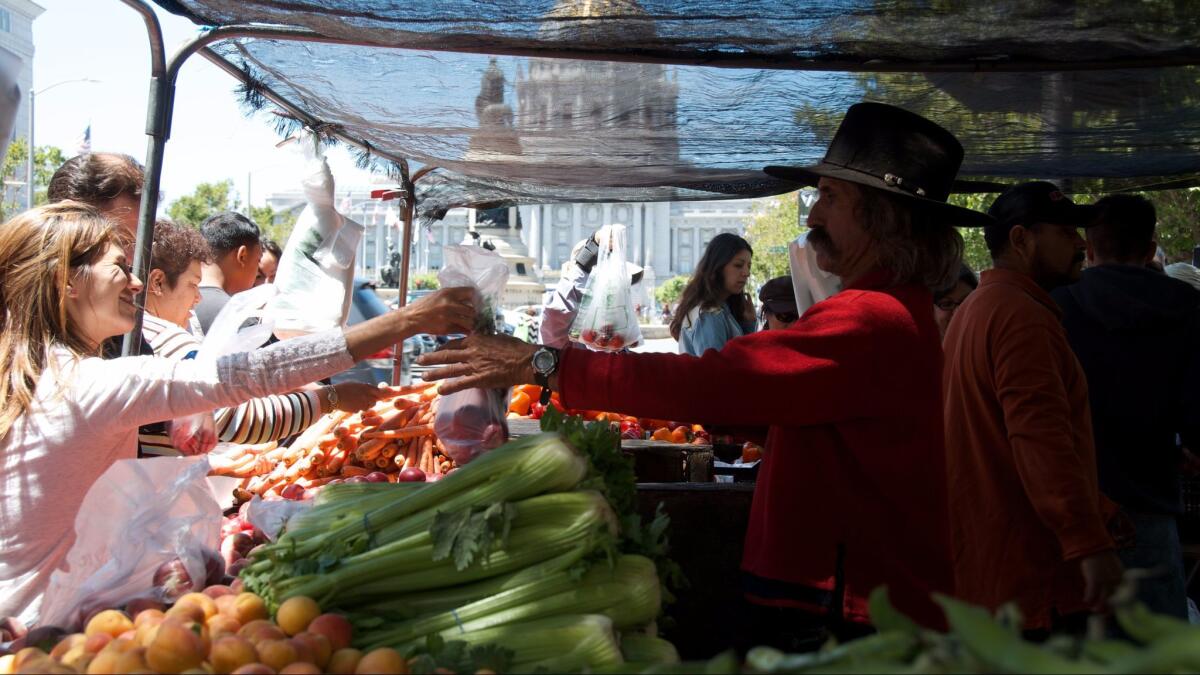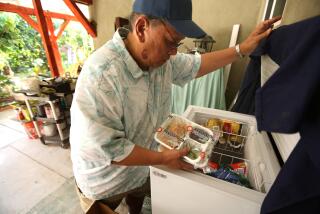How L.A. County is trying to sign more people up for food stamps — and why it’s not easy

- Share via
Vickie Williams’ favorite meal is baked chicken, string beans and corn on the cob. She often makes it for Sunday dinner for her 81-year-old mother, five grown children and four grandchildren.
Williams, a 58-year-old Gardena resident and former school cafeteria worker, estimates she spends at least $30 of the $194 in food stamps she receives each month on the meal. She doesn’t know how she’d get by without the help.
“It’s not just a privilege,” she said. “It’s needed. It really helps to put food on the table, hot food, especially when you have children.”
L.A. County officials are expanding their efforts to get more people like Williams signed up for food assistance.
For years, the county, like much of the state, has struggled to enroll all those eligible for California’s food stamp program, known as CalFresh. For a time, it was because of strict eligibility and application requirements, including fingerprinting applicants, requiring them to verify their eligibility every month and limiting the maximum gross income allowed.
California has eliminated those rules, yet it still ranks fourth from last in the nation when it comes to enrolling people in the food stamp program, according to federal data. Only 66% of those who were potentially eligible participated in the program in 2014, compared with 100% in Oregon and 99% in Tennessee.
Among California counties, Los Angeles ranks just below the middle, with 66.3% of those who are potentially eligible, or 1.1 million people, receiving benefits in 2015, according to state data. An additional 600,000 could qualify. San Bernardino County ranks first in the state, with 92.7% of its eligible residents receiving benefits.
How is it we could have two counties side by side, and one has 92% participation and one has 66%?
— Michael Flood, chief executive of the Los Angeles Regional Food Bank, comparing San Bernardino County’s high rate of food stamp enrollment to L.A. County’s
“San Bernardino has a lot of need, a lot of diversity, just like Los Angeles,” said Michael Flood, chief executive of the Los Angeles Regional Food Bank. “How is it we could have two counties side by side, and one has 92% participation and one has 66%?”
Flood, a member of the county’s Public Social Services Commission, has been pushing the county since October to overhaul how it processes applications for CalFresh. Last week the Board of Supervisors directed the Department of Public Social Services to do just that.
The board approved a motion by Supervisor Sheila Kuehl ordering the department to review how it receives and processes applications and to identify ways to improve enrollment, retention and reporting. The goal is to increase participation in CalFresh by at least 20 percentage points in two years.
In addition to helping more people put nutritious food on the table, increased CalFresh enrollment also allows the county to take advantage of essentially free money from the federal government. CalFresh benefits are fully funded through the federal Supplemental Nutrition Assistance Program, or SNAP; states and counties pay only administrative costs.
California Food Policy Advocates estimates that if CalFresh reached 100% of eligible individuals, L.A. County would receive an additional $1.2 billion in federal funding.
But President Trump’s proposed budget, released last week, would dramatically cut food aid and other assistance for the poor. Republicans have suggested making fixed block grants to states to cover the cost of such programs, rather than funding them per individual. Those grants are often based on current utilization of the program, so increasing the county’s rolls could help make the case for more federal funding.
L.A. County has tried to increase participation before. In 2001, the Department of Agriculture awarded two L.A.-based organizations funds to reach the elderly, immigrants and others who may not have been aware of the program. In 2010 L.A., along with the rest of the state, stopped using the term food stamps, shifting to CalFresh to remove some of the stigma associated with welfare. In 2011 it launched an online application.
“We’ve been working on this issue for 15, 16 years,” Flood said. “Has there been some improvement? Yeah, but we’d like to see more focus on it.”
Food policy experts and advocates who help clients enroll say there are a number of barriers to higher participation. In addition to the stigma, there remains a good deal of confusion about who is eligible, said Jessica Bartholow, a policy advocate with the Western Center on Law and Poverty.
People who receive Supplemental Security Income are not eligible, but people in their homes may be, and people who receive Medi-Cal, Social Security or Social Security disability might be. Many working people qualify, but for those who are self-employed or perform day labor, it can be hard to predict income or to know what constitutes an income change that must be reported.
In addition, many immigrants who are in the country legally are eligible to receive benefits, but those who are here illegally are not. Still, some who are eligible choose not to apply out of fear it will affect their ability to become a citizen or it will endanger their families.
That fear has only grown worse since Trump took office, officials and outreach workers say. Bartholow said her organization has received reports from across the state of people calling in to cancel their benefits.
Applying can also prove difficult for many low-income people. Long wait times at social services offices and on customer service telephone lines, a lack of transportation, the inability to take a day off work and limited Internet access among the poor pose significant barriers, Bartholow said.
Williams, who has been enrolled in CalFresh since 2010, has never tried to apply online, but she said that twice she sent in her paperwork by certified mail, only to arrive at the Public Social Services office and be told that it was never received. She goes in to renew her benefits every October, expecting the whole trip to take the better part of a day.
“It’s stressful,” she said.
Still, Williams is grateful for the program. No longer able to work, she said she collects $796 a month in Social Security disability, puts $675 of that toward rent and spends the remainder on food, bills and personal expenses. Occasionally she runs out of money at the end of the month.
“That’s a bad feeling,” she said. “Sometimes I do ask my children, but I try not to. They like to be independent, and so do I.”
Twitter: @AgrawalNina
ALSO
Medicaid is helping poor patients get needed care, even as Republicans push to cut it, study finds
On World Hunger Day, a look at why so many people don’t get enough food
More to Read
Sign up for Essential California
The most important California stories and recommendations in your inbox every morning.
You may occasionally receive promotional content from the Los Angeles Times.










